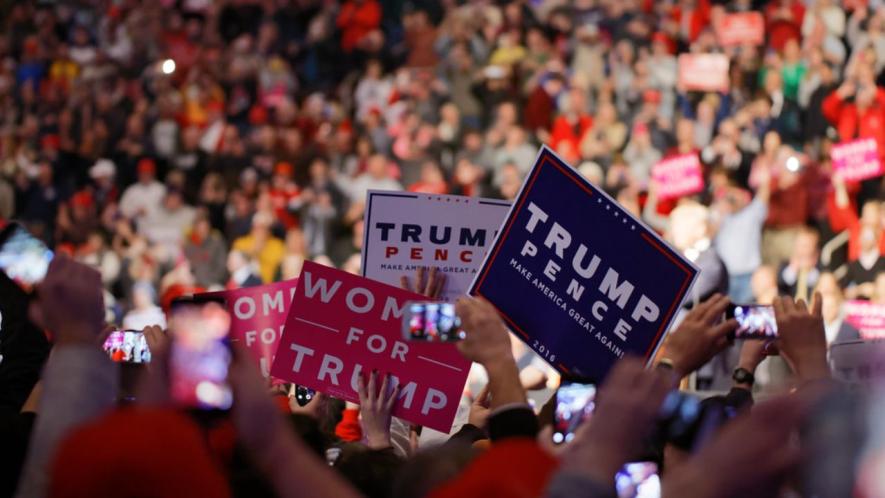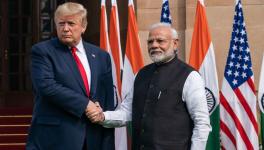Rethinking the Indian Response to Trump’s Tariff War

Image Courtesy: Flickr
The conspicuous silence in Indian mainstream media and policy discourse on viable responses to Trump’s tariff war reveals deeper dynamics of India’s position within the international political economy. Despite the far-reaching implications of the U.S. administration’s protectionist measures, there has been little substantive debate on potential retaliatory options available to India. This stands in stark contrast to China’s assertive and multi-pronged response, which has included reciprocal tariffs, export controls, formal complaints lodged with the World Trade Organisation, and targeted investigations into American firms operating within its territory. The divergence in response between the two countries offers critical insights into the ideological, institutional, and geopolitical constraints that shape India’s engagement with global economic power structures.
The Indian government’s response to Trump’s tariff war has been, at best, muted. A recent meeting between the U.S. President and the Indian Prime Minister epitomised this submissiveness. Even as the U.S. government was forcibly deporting Indian nationals; shackled, blindfolded, and transported in military aircraft in a manner starkly violative of human dignity. The Indian government chose denial over protest, publicly insisting that the deportees had not been ill-treated. Further, when Ananda Vikatan, a Tamil-language magazine, published a satirical cartoon critiquing the government’s silence on these humiliations, it was summarily censored under India’s draconian information technology legislation.
Such episodes highlight a broader incapacity to mount even a symbolic defence of Indian sovereignty when affronts originate from hegemonic global powers like the United States. This inability to respond meaningfully to external provocations, whether on trade, diplomacy, or the treatment of Indian citizens, raises important questions about the ideological and structural orientation of the Indian state.
Two interrelated factors underlie this posture of passivity. First, India’s ruling classes and their political apparatus remain deeply beholden to international finance capital, which is largely centred in the United States. Second, this dependency is compounded by a fundamental misreading of contemporary global political economy. These material realities are expressed ideologically through two distinct, yet convergent, wings of India’s neoliberal project: the neo-fascists and the cosmopolitan neoliberals. While the former deploy a pseudo-nationalist rhetoric and the latter a pseudo-internationalist one, both ultimately converge in their reluctance to challenge U.S. imperialist hegemony. Their divergence lies only in the rhetorical justifications they offer for this subservience. These arguments merit closer scrutiny.
One strand of cosmopolitan neoliberal thought argues, somewhat brazenly, that Trump’s tariff war offers India an opportunity to unilaterally reduce its own tariffs. They claim that such a reduction would boost domestic competition and thereby improve economic efficiency. However, this argument is logically inconsistent: if lowering tariffs unconditionally leads to better outcomes, why does the U.S., the world’s most powerful economy, choose to increase them?
Other cosmopolitan neoliberals argue that India is a small open economy while the US is a large open economy, implying that world prices are given as far as the Indian economy is concerned while the US is capable of at least partially influencing world prices. Therefore, it would be unwise for India to engage in retaliation vis-à-vis the the imposition of tariffs by the US. On the face of it, this argument seems somewhat logical and therefore let us examine this further. While it is true that the Indian economy is smaller than the U.S. economy in terms of share of world income, for a number of commodities that India does import and export, the respective share of India's imports and exports in the total world trade is non-negligible. Therefore, the ability of India to partially determine the pricing of its imports and exports can be an element in its trade policy including tariff retaliation.
Moreover, the very structure of Trump's tariff war, which involves differential tariffs on different countries, is a tactic designed to try and prevent coordinated opposition to Trump's trade policy. Therefore, it would be relevant for India to work in multilateral forums such as the BRICS to prepare strong and coordinated responses to Trump's tariff war. However, whenever there emerges a debate around working in multilateral forums such as BRICS to counter Trump's tariff force, both cosmopolitan neoliberals as well as the neo-fascists might immediately argue that BRICS is dominated by China and that the interests of China and India diverge. Therefore, joint action against US hegemonic actions such as Trump's trade war is not possible. However, this is a self-defeating argument and actually amounts to creating non-tariff barriers in the trade between China and India which weakens India's bargaining power with respect to US imperialist hegemony.
For example, cosmopolitan neoliberals as well as neo-fascists often claim that software semiconductor chips made in China could be hacked by the Chinese government and therefore would be inappropriate for use in the Indian economy. Let us assume for the sake of argument that this claim is true. Is there any reason to claim, on the contrary, that semiconductor chips that are designed or produced using US technology cannot be or will not be hacked by the US government? After Edward Snowden's revelations even those working outside governments know the facts about global surveillance by the US government. Under these circumstances, a prudent option available to India would to diversify its chip demand between two or more sources so that no one foreign government can exercise undue leverage in matters of security vis-à-vis India. While this would be the short-run course that would be appropriate in the case of countries like India, over the long run, efforts should be made to develop an indigenous semiconductor industry.
Another common claim by both ideological segments of the Indian neoliberal project is that U.S. tariffs on Chinese goods provide Indian industry with a relative advantage, potentially encouraging multinational corporations to shift production from China to India. However, this argument too is completely disconnected from the concrete situation concerning global production networks. China exercises a leading position in almost all reaches of the technological ladder that pertains to global production networks due to its advantages in infrastructure, skilled labour with respect to wages, domestic demand, the role of the public sector, state support to innovation, and industrial policy (which involves among other things a euthanising of finance capital and the political neutering of enterprise capital). Most of these conditions are incompatible with contemporary Indian political economy and therefore cannot be replicated here without relevant political changes. Therefore, multinational corporations are unlikely to significantly relocate production capacity to India due to Trump's trade war.
Moreover, any process of industrialisation in any country of the world would require for its continuance some Chinese inputs and/or some access to Chinese markets to be sustainable. Under these circumstances, the question before any country, including India, is not whether to engage or disengage from China, but how best to engage with China. The Economic Survey of 2023-2024 had pointed out that India should explore the option of involving itself in global production networks centered in China. However, progress in this respect has been slow and expectedly subject to counter-pressures from cosmopolitan neoliberals as well as sections of the neo-fascist dispensation in India.
Vietnam offers a valuable lesson in strategic diplomacy. Its ability to maintain productive relationships with multiple great powers, without being beholden to any, demonstrates an autonomous balancing strategy. For India, the path to greater sovereignty lies in rejecting the binary of alignment with either the U.S. or China, and instead adopting a policy framework driven by authentic national interests (which is centred around the working people). In order to understand this proposition, let us examine the actual leverage that foreign countries exercise over India.
The fundamental leverage that U.S. monopoly capital exercises over India is through the hegemony of international finance capital that is centered in the U.S. Since India does not have effective capital controls, this allows U.S. monopoly capital to exercise effective power over Indian policymaking. One exception to this trend was when the Biden administration tried to pressure Indian government to cut relations with Russia. The Indian government could not accede to this US demand because the Chinese-Russian strategic concord that would have emerged may have been directed against India. This strategic concord could not have been counterbalanced by the strategic proximity that may have emerged between India and the USA. But in most other matters, the U.S. monopoly capital has been able to influence, to a very significant extent, the contours of policymaking in India. Consider, for instance the examples of India's relations with Iran, with Venezuela, on the question of the conflict in Palestine, and so on. The contrast with US attempts to exercise similar leverage over China or Russia is readily evident.
In the absence of effective capital controls, international finance capital, primarily centred in the United States, continues to serve as a conduit through which U.S. monopoly capital exercises considerable influence over Indian economic policymaking. This structural dependence finds its ideological expression in the distinct yet convergent narratives of cosmopolitan neoliberals and the neo-fascist dispensation.
On the one hand, neo-fascists have intensified a differential squeeze on the socially oppressed (such as Indian Muslims) under the guise of cultural nationalism and security. This project is part of a broader attempt to erase what remains of India’s anti-imperialist legacy from the freedom struggle. On the other hand, cosmopolitan neoliberals, while cloaked in liberal internationalism, contribute to the same erasure by sanitising colonial history and glorifying imperialist globalisation. Though their methods differ, both ideological strands ultimately function to sustain the hegemony of metropolitan capital.
At the core of any meaningful anti-imperialist position lies the understanding that broad-based economic progress in the Global South is not possible without directly confronting the hegemony of metropolitan capital. The recent efforts of U.S. monopoly capital and its state apparatus to drive a wedge between China and Russia is a tactic aimed at forestalling the emergence of a multipolar economic order indicating the waning strength of U.S. imperialist dominance. Against this backdrop, restoring policy autonomy for India must begin with the imposition of robust capital controls on international finance. Once this critical step is taken, several policy options become viable to counter the effects of Trump’s tariff war:
One, India must reduce its excessive reliance on the U.S. market for specific commodity exports. While the U.S. may currently offer higher returns for certain export goods, this concentration increases India’s vulnerability to external leverage. A geographically diversified export strategy will enhance India’s bargaining position across all markets. Such a strategic reorientation, especially one that considers long-term national interest is best undertaken through initiatives involving the public sector, which operates with a longer policy horizon than private actors driven by short-term profitability.
Two, India should actively attract greenfield foreign direct investment (FDI), from both the U.S. and China, in carefully selected sectors and regions. These choices must be guided by a coherent industrial policy aimed at enabling India to appropriately ascend the technological ladder of global production networks while not compromising the objective of full employment. Simultaneously, this policy should aim to reduce regional disparities within India by dispersing industrial development beyond existing hubs.
Three, Resist Pressure to Reduce Import Tariffs, Especially in Agriculture and Key Inputs as succumbing to U.S. demands for reducing import tariffs, particularly on agricultural products would further pauperise India’s already vulnerable peasantry and agricultural labour force. A related argument advanced by cosmopolitan neoliberals claims that high-priced inputs supplied by large domestic firms disadvantage micro, small, and medium enterprises (MSMEs), and that reducing import tariffs would level the playing field and boost MSME exports. However, such logic is deeply flawed. Lowering tariffs on critical inputs may indeed reduce costs for MSMEs in the short run, but it is likely to trigger an import surge that undermines domestic production, employment, profits, and investment in import-competing sectors.
In the current global environment, where export prospects are weakening this would have contractionary effects across the economy. Furthermore, once domestic competitors are displaced, foreign suppliers may increase input prices, thereby nullifying any temporary advantage gained by MSMEs. The structural disadvantage faced by Indian MSMEs in relation to monopoly capital cannot be addressed by import liberalisation. Instead, it demands active policy intervention that redistributes resources away from monopoly capital towards MSMEs. This may include public sector production of essential inputs at regulated prices to mitigate cost pressures faced by MSMEs.
Reviving the Anti-Imperialist Legacy
The ideological currents that dominate Indian policy discourse, be they cosmopolitan neoliberals or neo-fascists, seek to suppress the anti-imperialist ethos that once animated India’s freedom movement. The former sanitise colonial history; the latter attack marginalised communities within the country. Both ultimately serve the interests of metropolitan capital. Genuine anti-imperialism today must recognise that sustainable development in the Global South requires breaking free from the grip of metropolitan capital. The growing strategic anxieties of U.S. monopoly capital, exemplified by attempts to isolate China and Russia signal a waning imperialist order. For India, this moment demands bold and thoughtful policy shifts aimed at recovering national sovereignty, economic justice, and strategic autonomy.
Shirin Akhter is Associate Professor at Zakir Husain Delhi College, University of Delhi. C Saratchand is Professor, Department of Economics, Satyawati College, University of Delhi. The views are personal.
Get the latest reports & analysis with people's perspective on Protests, movements & deep analytical videos, discussions of the current affairs in your Telegram app. Subscribe to NewsClick's Telegram channel & get Real-Time updates on stories, as they get published on our website.
























